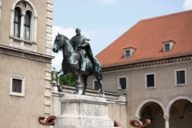
The reign of Prince Regent Luitpold (1886-1912) is considered to be Munich's “Golden Age”. Never before had there been so much art and industrial progress witnessed in the city. No Wittelsbacher before him had ever shouldered the weight of a more difficult time, as did Luitpold after the enigmatic death of King Ludwig II.
Prince Regent Luitpold is considered one of the most important representatives of Bavarian kingship. There are “Prinzregentenstrassen” and monuments in almost every major city in Bavaria. In Munich, Café Luitpold even named its restaurant after him. Opened in 1888, in the day it was the city's most modern and magnificent café, and continues to thrive to this very today at Brienner Strasse 11. Oh and by the way, another sweet historical witness from a bygone time that has been preserved until this day: the “Prinzregententorte” (cake).
But in actuality, everything should have been different: Luitpold was born on 12 March 1821 in Würzburg. He was the fifth child of King Ludwig I and Princess Therese of Sachsen-Hildburghausen. On the orders of his father, he joined the military at the age of 14. After completing his training, he was promoted to colonel and thus commander in 1841 with the First Munich Artillery Regiment – and what was the start of a wonderful military career.
On one of his numerous trips abroad, Luitpold met Auguste Ferdinande of Habsburg-Este, the daughter of the Grand Duke of Tuscany, in Florence. The couple married on 15 April 1844 in Florence. What made it special at the time: It was a marriage of love. The two were blessed with four children, including the later King Ludwig III.

Two events would then change Luitpold's life in rapid succession. At first, in 1861, he was dealt a heavy blow. His wife died in Munich at the age of 39. Luitpold never married again. Soon thereafter, in 1864, he became Ludwig II., King of Bavaria. Given the “Fairytale's King’s” preference for retiring to his fantasies and dream castles, Luitpold became increasingly tasked with performing certain representative tasks for his nephew.
At that time, the situation was becoming more and more obvious: Given that Ludwig’s mamouth castle projects meant that the house of Wittelsbach was becoming increasingly indebted. At the same time, the unworldly and despicable king was clearly failing to fulfil his political duties in any way whatsoever. Consequently, King Ludwig II incapacitated and deposed on 9 June 1886. Only a few days later, on 13 June 1886, he drowned in the most mysterious circumstances in Starnberger See (lake). The next contender for the throne was now Luitpold alone, for Otto I, the brother of Ludwig II, had been regarded since his birth as mentally unwell, and therefore unable to govern.
And Luitpold took the reigns at 65 years of age to become the Prince Regent. But it was a colossal effort. Bavaria was deep in crisis at that time. The people’s anger at the lavish Sun King and his behaviour was immediately transferred onto the Prince Regent. He had to tolerate accusations of a lust for power and perhaps even certain murderous machinations.

And yet this did not detract him from the matters at hand. This is because Luitpold stood, above all, for old Bavarian virtues: His modest, rather sober manner, his sense of duty and his love of art and nature were a great fit with the times. In almost 27 years as Prince Regent, Munich and the nowadays district Schwabing in particular went on to experience a great cultural boom.
In the course of industrialisation, Munich grew from a rural expanse to a dynamic industrial city. The birth of the telegraph and the phone changed the world. Railroad was also expanded. In Munich, new industries began to settle. Tourism became an important source of income for the city and its inhabitants. The influx of people and business was enormous during this time. People still speak of Munich's “Golden Years”.
When Prince Regent Luitpold died on 12 December 1912 at the age of 91 at the Münchner Residenz, the population’s grief was both palpable and probably very real. Emperor Wilhelm II described Luitpold during his eulogy as the “last knight”.
The Prince Regent was buried in the Theatinerkirche (church) in the Wittelsbach family tomb, where his sarcophagus can still be visited to this day.